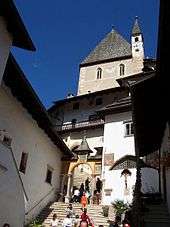Romedius
Saint Romedius (Italian: San Romedio; died c. 4th century) was a son of the Tyrolese count of Thaur in the Inn valley near Innsbruck). Though the son of a nobleman, as a young man he withdrew to a rock cave in order to meditate. After the death of his parents, he gave away all of his possessions and established himself in the Val di Non (German: Nonstal) in Trentino.
Saint Romedius | |
|---|---|
| Born | Thaur, Tyrol |
| Died | c. 4th century |
| Venerated in | Roman Catholic Church |
| Feast | January 15 |
| Attributes | depicted riding a bear; alongside a bear; tamed bear |
Romedius is often depicted alongside or astride a bear. According to his hagiography he wanted to visit the friend of his youth, St. Vigilius, Bishop of Trento (who died in 405), but his horse was torn to pieces by a wild bear. Romedius, however, had the bear bridled by his disciple David (Davide). The bear became docile and carried Romedius on its back to Trento.[1] The tamed bear is a motif also of Saint Corbinian, bishop of Freising.
Veneration

Upon Romedius' death, his body was laid to rest in a small tomb above his cave in the mountains, a site that was soon visited by pilgrims. The Sanctuary of San Romedio grew from the little church that was built to venerate him to the popular pilgrimage shrine, the Santuario di San Romedio is across the lake from Cles at the head of the Val di Non, above the village of Sanzeno. The sanctuary where Romedio lived with his bear companion is a complex of several churches, from the Romanesque period to the 20th century beyond a gateway in the forested slopes. Votive offerings of crutches line the walls of the narrow stone stairwell up to the highest chapel, said to mark the site of the saint's retreat.
His local cult, which consolidated itself in the course of the 11th century, was officially recognized in the twelfth by the Bishop of Trento. In 1795, permission was given to read masses in his name in the diocese of Brixen, which at that time included the Northern Tyrol. His cult remains popular in Trentino, Bavaria, and the Tyrol.
Romedius' Bear
In remembrance of this legend, in 1958 Italian Senator G. G. Gallarati Scotti, honorary member of the committee for the foundation of the World Wildlife Fund in Italy, purchased Charlie, a bear intended to be killed, and donated it to the Sanctuary of San Romedio, in the Valle di Non.
Today, the Province of Trentino protects the last brown bears of the Alps in the Adamello-Brenta National Park, and, near the Sanctuary, takes care of young bears born in captivity in Trentino .
In the work known as Illustrissimi, a collection of letters written by Pope John Paul I when he was Patriarch of Venice, Romedius' bear is one of the "recipients" of the letters.
See also
- Saint Romedius Community
References
- A similar tale is told of Saint Psalmodius.
- The Legend of San Romedio (with children's drawings)
- Annegret and Peter Kokschal, 2002. Die Heiligen für Jeden Tag (Leipzig) (pdf file)
- (in Italian) San Romedio